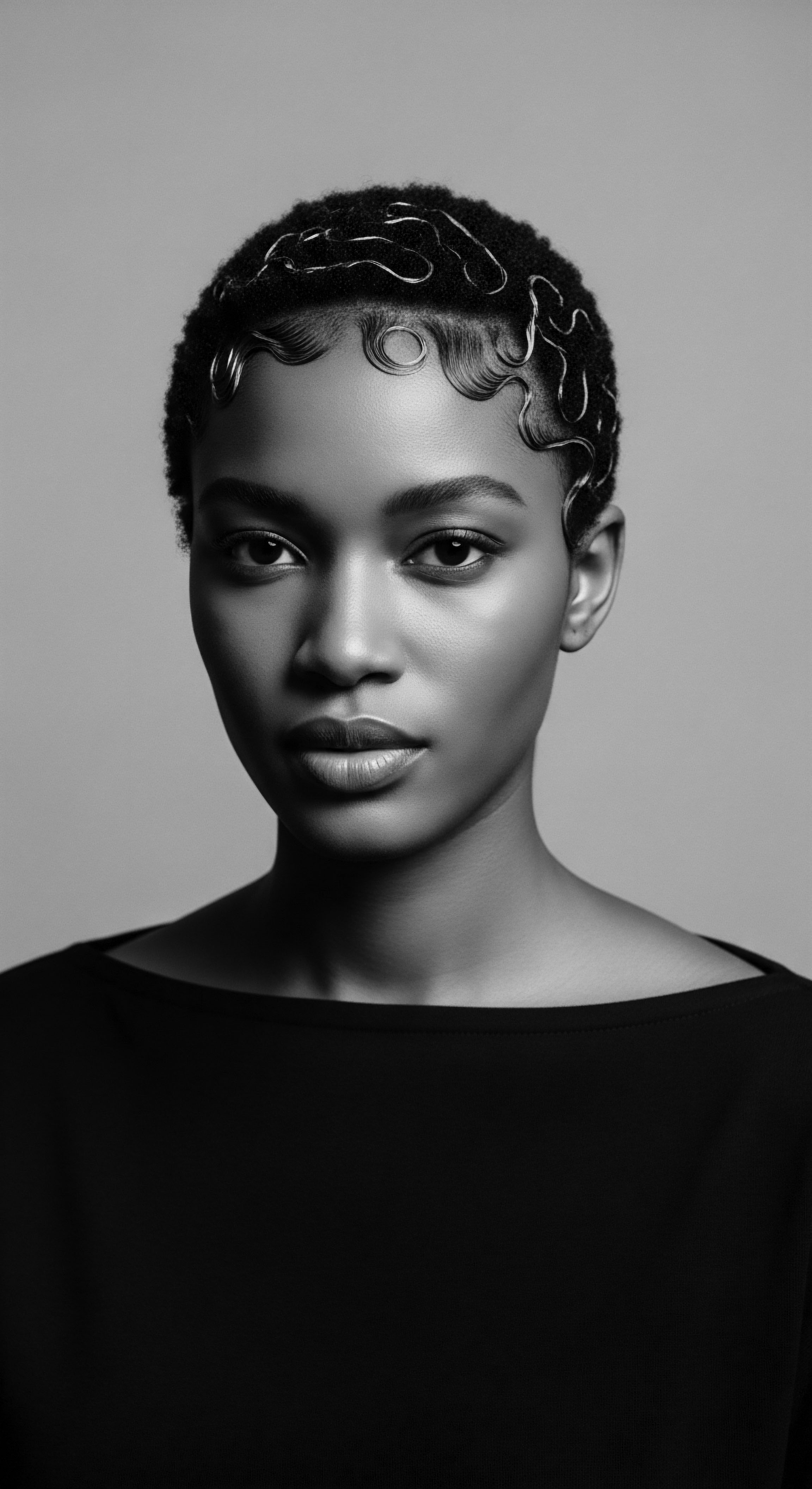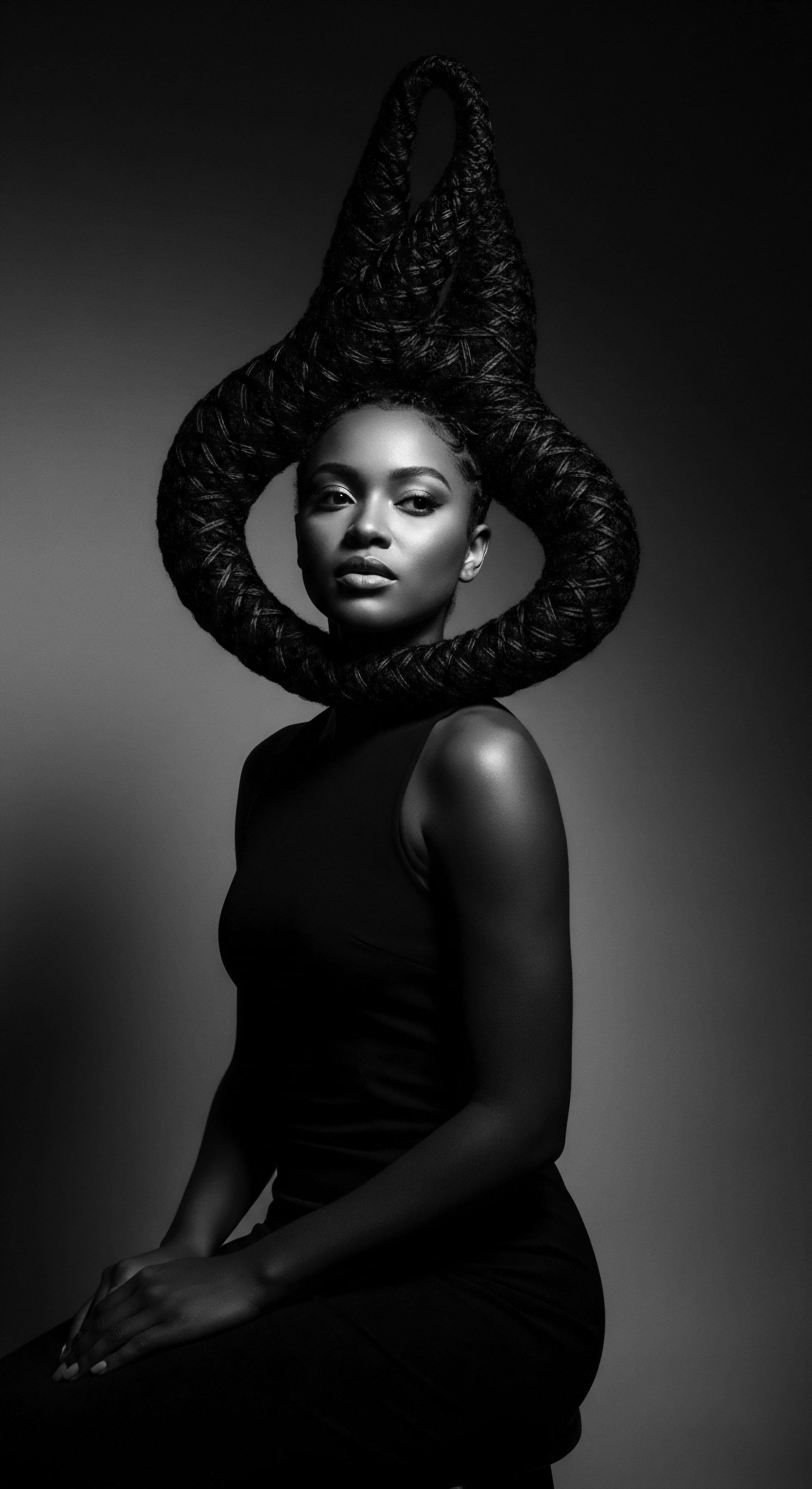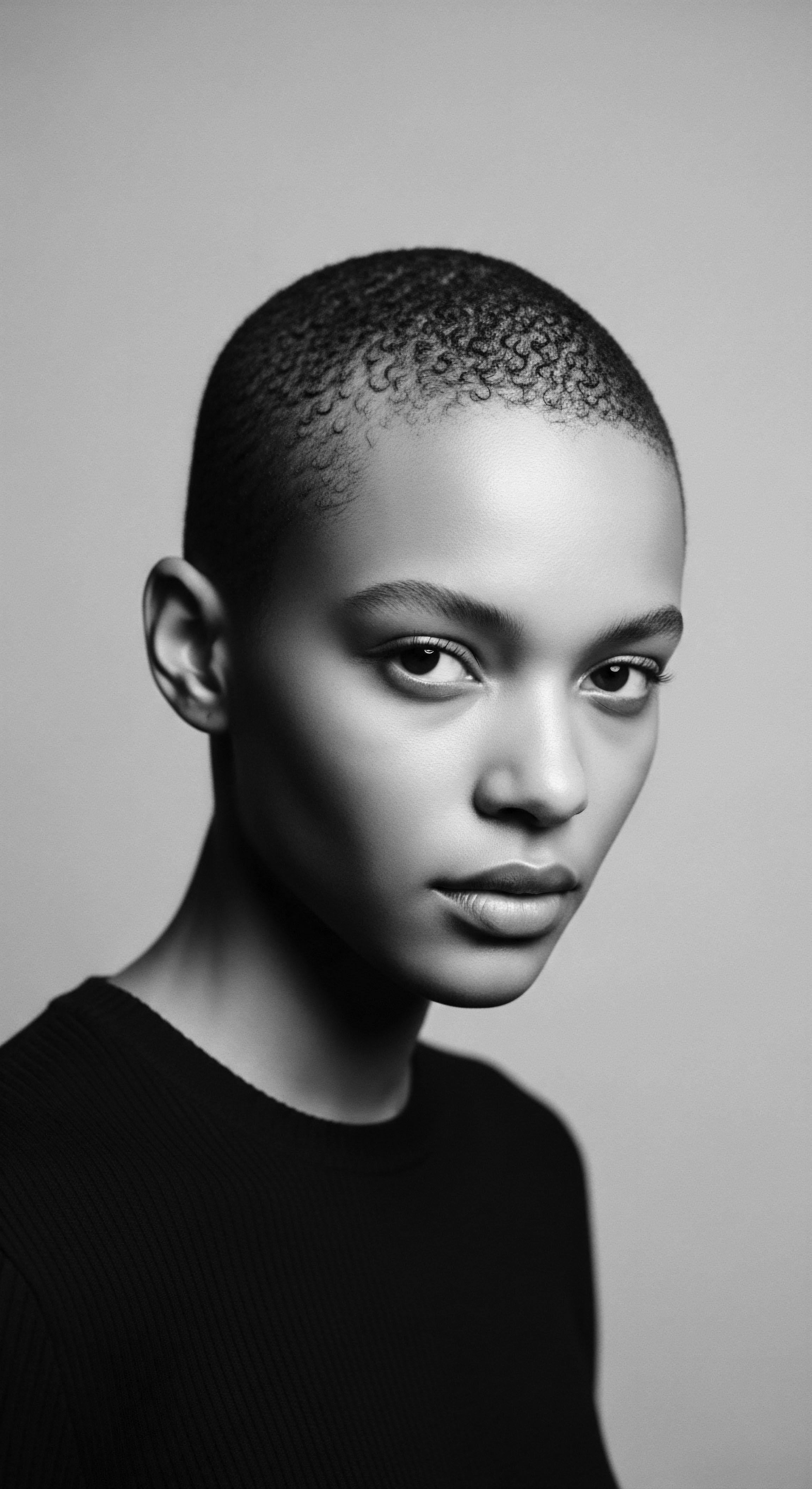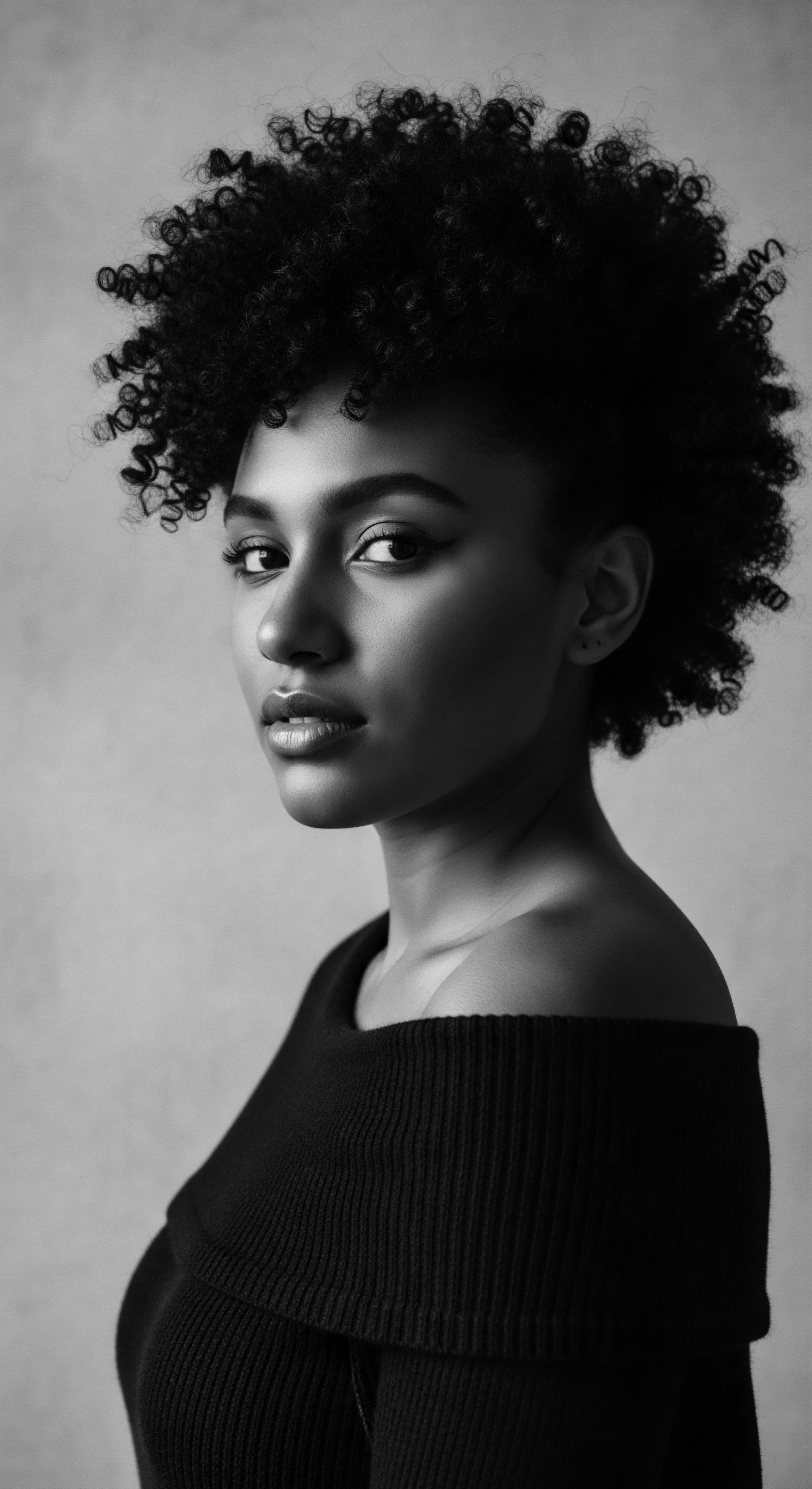
Roots
To journey into the ways hair oiling honors the profound resilience of Black hair is to trace an ancestral path, a lineage etched into the very helix of each textured strand. This is not a simple accounting of ingredients or a mere enumeration of steps; it is an exploration of memory, of inherited strength, and of wisdom passed through generations. We consider how this deeply rooted practice, hair oiling, connects with the fundamental understanding of textured hair, both from a historical and a contemporary scientific perspective, always through the lens of a rich heritage. The narrative of Black hair is inherently one of survival, adaptation, and an unwavering affirmation of self, where hair oiling stands as a quiet yet powerful act of continuity.

What is the Ancestral Understanding of Textured Hair?
Long before the modern trichology laboratory, communities across Africa possessed a profound, intuitive grasp of their hair’s unique qualities. For ancient Africans, hair was more than adornment; it served as a symbolic tool to convey social status, heritage, culture, religion, and family background. Intricate styles, such as braids, twists, and dreadlocks, indicated a person’s tribe, marital status, age, and social rank. This deep reverence for hair meant understanding its needs intimately, leading to the development of indigenous care practices.
The Himba tribe in Namibia, for instance, coated their hair with a paste of red ochre, aromatic resin, and animal fat (otjize) not only for beauty but also for practical protection from the sun and insects. This historical knowledge, born of observation and adaptation to diverse environments, laid the foundation for haircare rituals that sustained hair health in ways often overlooked by Western frameworks.
Hair oiling, in this context, arose from a visceral understanding of hair’s inherent tendencies. Textured hair, with its characteristic coils and curls, exhibits a unique morphology. The helical structure of each strand, sometimes flattened or elliptical in cross-section, makes it prone to dryness because the natural oils from the scalp struggle to descend the winding hair shaft. Ancient African communities recognized this need for external moisture and protection, turning to the abundant natural resources of their lands.

How Does Biology Inform Hair Oiling’s Role?
Modern science validates much of this ancestral wisdom. Textured hair, particularly Type 4 (coily or kinky) hair, is characterized by its tight, dense structure and unique curl pattern, which can lead to increased dryness, brittleness, and susceptibility to breakage. The cuticle layers, which act as a protective barrier, may be more open or raised in textured hair, making it more vulnerable to moisture loss and external damage. This inherent predisposition to dryness makes external lubrication indispensable for maintaining strand integrity and flexibility.
Oils, composed primarily of fatty acids, act as emollients, creating a protective barrier on the hair shaft that helps to seal in moisture and prevent its escape. Some oils, like coconut oil, possess a low molecular weight and linear chain, allowing them to penetrate the hair shaft and reduce protein loss, offering internal reinforcement in addition to external conditioning. This dual action of sealing and penetrating directly counters the natural challenges posed by the structure of textured hair. The traditional African practice of incorporating oils was, in effect, an early form of bio-mimicry, working in harmony with the hair’s elemental biology to promote its resilience.
Hair oiling emerged from ancient wisdom, deeply understanding textured hair’s intrinsic needs for moisture and protection.

What Traditional Oils Were Used for Hair Care?
The African continent, with its incredible biodiversity, offered a pharmacopeia of natural oils and butters that became central to hair care. These plant-derived remedies were not simply applied; they were often harvested, processed, and combined with other elements like herbs or clays, creating bespoke blends tailored to specific needs and communal traditions.
- Shea Butter ❉ Extracted from the nuts of the Vitellaria paradoxa tree, often revered as “The Sacred Tree of the Savannah,” shea butter is a rich source of moisturizing properties, widely used for both hair and skin. Its traditional use across West Africa is well-documented, offering deep conditioning and protection.
- Coconut Oil ❉ Although globally used, coconut oil found its place in various African hair care traditions, particularly in coastal regions where coconut palms thrived. It is known for its ability to penetrate the hair shaft, providing intense moisture.
- Castor Oil ❉ Known for its thick consistency and rich fatty acid content, castor oil, particularly Black Castor Oil, became a staple in many diasporic communities, linked to hair strengthening and growth. Its ancestral roots stretch back to Africa, used for various beauty and medicinal purposes.
- Marula Oil ❉ Originating from the kernels of the Marula fruit, this oil, often called “liquid gold,” is rich in antioxidants and essential fatty acids. It has been a beauty secret in many African communities in Southern Africa, offering lightweight moisture.
This diverse range of botanical resources highlights the ingenuity of ancestral practices, selecting ingredients based on empirical observation and a profound connection to the land. The use of these oils demonstrates a holistic approach to wellbeing, where personal adornment intertwined with environmental harmony and cultural expression.
| Aspect of Hair Hair Structure |
| Ancestral Understanding (Pre-Colonial Africa) Recognized as varied, with differences in curl pattern and texture. Observed vulnerability to dryness and breakage. |
| Modern Scientific Insight (Validated by Research) Microscopic analysis reveals coiled, elliptical cross-sections. Cuticle layers may be lifted, affecting moisture retention. |
| Aspect of Hair Moisture Needs |
| Ancestral Understanding (Pre-Colonial Africa) Understood the need for external hydration and sealing. Used oils and butters to lubricate and protect against elements. |
| Modern Scientific Insight (Validated by Research) Science confirms textured hair's propensity for dryness due to impeded sebum flow and cuticle structure. Oils seal moisture. |
| Aspect of Hair Hair Strength |
| Ancestral Understanding (Pre-Colonial Africa) Associated healthy, cared-for hair with strength and vitality, resisting breakage during daily life and styling. |
| Modern Scientific Insight (Validated by Research) Oils (e.g. coconut oil) penetrate, reducing protein loss and reinforcing the hair shaft. External application protects from environmental stressors. |
| Aspect of Hair The enduring wisdom of ancestral care practices aligns with contemporary scientific understanding, affirming the profound heritage of hair oiling. |
This foundational understanding, passed from elder to youth, informed a comprehensive approach to textured hair, one that respected its unique characteristics and honored its place within cultural identity. Hair oiling, therefore, serves as a testament to indigenous ecological knowledge and a heritage of self-sufficiency.

Ritual
The ritual of hair oiling transcends mere application; it is a communion with ancestral practices, a tender conversation held between hands and scalp, steeped in generations of care. This section delves into how hair oiling has influenced and continues to shape the heritage of Black hair styling, from foundational techniques to intricate transformations. It is a story of adaptation and defiance, where the very act of maintaining one’s crown became a statement of cultural preservation against efforts to diminish Black identity.

How Did Oiling Shape Traditional Styling Techniques?
Within countless African societies, hair styling was a communal affair, often performed outdoors under the warm sun, a time for sharing stories and strengthening bonds. Oiling was an integral part of these gatherings, preparing the hair for the labor-intensive artistry of braiding, twisting, and knotting. Before the intricate patterns of cornrows or Bantu knots took form, strands would be coated with nourishing oils and butters, providing the necessary slip and pliability for manipulation. This careful preparation minimized breakage and allowed for the creation of styles that could last for weeks, offering both aesthetic beauty and practical protection from the elements.
The application of oils rendered the hair more manageable, easing the process of detangling and sectioning. This practice was particularly vital for maintaining the health of hair during periods when daily washing was not feasible or desirable due to resource scarcity or environmental conditions. Oiling preserved the hair’s moisture, enabling it to withstand the tension of protective styles and maintain its integrity over extended periods. This foresight in preparation is a hallmark of ancestral hair care, a wisdom designed to prolong the life and vitality of the hair itself.

What is the Significance of Oiling in Protective Styling?
Protective styles, deeply rooted in African heritage, are a cornerstone of textured hair care. They shield the delicate ends of the hair, reduce manipulation, and encourage length retention. Hair oiling stands as a silent partner in this tradition.
Before braiding or twisting, a generous coating of oil or butter forms a protective layer, cushioning the strands against friction and environmental stressors. This pre-styling ritual minimizes the risk of damage during the styling process and maintains hydration within the enclosed style.
Consider the use of oils with styles like cornrows , which have historical significance dating back thousands of years and served as a means of communication and even as maps to freedom during the transatlantic slave trade. Preparing the hair for such intricate, long-lasting styles necessitated a robust moisture barrier. Similarly, for Bantu knots , originating from the Zulu people of Southern Africa and serving as symbols of femininity and status, proper oiling ensured the integrity of the tightly wrapped sections, allowing them to hold their shape and preventing dryness. The act of oiling prior to these styles honors a legacy of ingenuity, adapting hair care to serve deeper purposes of survival and cultural continuity.
Hair oiling is a foundational practice, preparing strands for protective styles that preserve integrity and cultural identity.

How Does Hair Oiling Support Hair Adornment and Legacy?
Beyond their structural benefits, oils played a part in the aesthetics and symbolism of traditional hair adornment. The healthy sheen imparted by oils enhanced the visual appeal of intricate styles, making beads, cowrie shells, and other precious adornments stand out. In many societies, the hair, adorned and cared for, became a canvas for storytelling, reflecting achievements, marital status, or spiritual connections.
For instance, the Himba women’s use of otjize, a mixture that includes butterfat, also colors their hair a distinctive red-orange, symbolizing blood, fertility, and their connection to the earth and ancestors. This highlights how oiling extended beyond health to serve ceremonial and expressive functions.
Even during the brutal era of the transatlantic slave trade, when enslaved Africans were often stripped of their traditional tools and forcibly shaved as an act of dehumanization, the memory of hair care, including oiling, persisted as an act of resistance. Women would use what meager resources were available, sometimes axle grease or cooking oil, to care for their hair, striving to maintain a connection to their heritage and identity despite oppressive conditions (Kelley, 1997, p. 346). This demonstrates hair oiling’s enduring role not only in physical hair maintenance but as a steadfast symbol of cultural continuity and defiance.
| Styling Element Preparation for Styling |
| Traditional Application of Oiling Provided slip for detangling and sectioning. Ensured malleability for intricate braids and twists. |
| Contemporary Relevance of Oiling Conditions hair, reduces friction, and minimizes breakage during manipulation. Creates a smoother surface for defining curls. |
| Styling Element Protective Styles |
| Traditional Application of Oiling Shielded hair within long-term styles, prevented moisture loss in arid climates. |
| Contemporary Relevance of Oiling Seals moisture into strands, supporting length retention and reducing damage in braids, twists, and locs. |
| Styling Element Aesthetic & Symbolic |
| Traditional Application of Oiling Imparted a healthy sheen, enhancing adornments. Used in ceremonial pastes for cultural expression. |
| Contemporary Relevance of Oiling Contributes to the natural luster of textured hair. Supports healthy hair appearance as a source of cultural pride. |
| Styling Element From ancient communal rituals to modern regimens, hair oiling consistently upholds the aesthetic and protective heritage of Black hair. |
The consistent use of oils across diverse African and diasporic contexts underscores its profound integration into the very artistry of Black hair. It is a quiet language of care, whispered from one generation to the next, preserving not only the health of the hair but also the spirit of a people determined to keep their cultural memory alive. The rhythmic motions of oiling, whether in preparation for a ceremonial style or a daily routine, serve as a living testament to a heritage that refuses to be forgotten.

Relay
The enduring practice of hair oiling, passed from elder to youth, represents a continuous relay of ancestral wisdom, informing holistic care and problem-solving for textured hair today. This section delves into the intricate connections between ancient rituals, scientific validation, and the profound role of oiling within a comprehensive hair care regimen, all examined through the unwavering lens of heritage. It is here that we uncover how deep understanding, rooted in centuries of observation, continues to guide contemporary approaches to hair health and cultural expression.

What is the Science Behind Traditional Hair Oils?
For millennia, diverse communities across Africa recognized the therapeutic and protective qualities of various indigenous botanicals. Shea butter, often lauded for its ability to relieve dry skin and soothe irritation, found widespread application as a hair sealant and conditioner due to its rich fatty acid profile. Similarly, the use of coconut oil, especially in regions where the coconut palm thrives, provided deep moisture and helped reduce protein loss in hair strands. These traditional choices align remarkably with modern scientific understanding of lipid chemistry and hair biology.
Oils are composed of triglycerides, which are esters of glycerol and fatty acids. Different fatty acids have varying molecular weights and structures, influencing their ability to penetrate the hair shaft or remain on the surface. For instance, lauric acid, a saturated fatty acid found abundantly in coconut oil, has a low molecular weight and a straight linear chain, granting it a high affinity for hair protein and the capacity to penetrate the hair cortex.
This penetration helps to reduce hygral fatigue, the swelling and shrinking of hair as it absorbs and loses water, which can lead to breakage, especially in highly porous textured hair. Other oils, while not penetrating as deeply, coat the hair shaft, providing a protective occlusive layer that seals in moisture and shields against environmental damage.
Furthermore, many traditional oils are replete with vitamins (such as A, C, and E) and antioxidants, which contribute to scalp health and protect hair follicles from oxidative stress. The anti-inflammatory and antimicrobial properties present in some indigenous oils also help maintain a balanced scalp microbiome, a foundation for healthy hair growth. This scientific validation underscores the profound wisdom embedded in ancestral practices, confirming their efficacy beyond anecdotal evidence.

How Does Oiling Support Nighttime Hair Sanctuary?
The reverence for hair in many African cultures extended to its protection during rest. Nighttime rituals, often involving the application of oils, butters, and the use of head coverings like bonnets, were not simply about preserving a hairstyle; they were acts of self-care and continuity, safeguarding the hair’s integrity as one transitioned from day to night. This consistent nightly maintenance, steeped in the belief that hair is a sacred crown, prevents tangling, minimizes friction against sleep surfaces, and retains the moisture carefully applied earlier in the day.
The bonnet, a seemingly simple accessory, carries a powerful legacy. Its use, often a continuation of head-wrapping traditions, became a practical adaptation in the diaspora to protect hair from the dryness of various climates and the friction of Western bedding materials. By enclosing the hair, bonnets, especially those made of satin or silk, reduce moisture evaporation and prevent cuticle damage, which is particularly vital for delicate textured strands.
The application of a nourishing oil before donning a bonnet amplifies these protective benefits, creating a sealed environment that allows the oil to condition the hair more effectively overnight. This ritual represents a quiet act of preservation, ensuring that the labor of daily hair care is not undone during sleep, a testament to enduring wisdom.
Ancestral traditions of hair oiling and nighttime protection remain relevant, validated by science and echoing through modern self-care rituals.

What Are the Ancestral Solutions to Hair Concerns?
Historically, communities relied on the immediate environment for solutions to hair challenges. Dryness, a common concern for textured hair, was addressed through the liberal and consistent application of oils and butters. The practice of oiling the scalp, often referred to as “greasing,” was a traditional method for addressing perceived “dry scalp,” which, though sometimes effective for hydration, can, in certain instances, contribute to issues like seborrheic dermatitis if oils are too heavy or applied excessively without proper cleansing, as some research suggests Malassezia growth can be propagated by lipids. This nuanced understanding highlights the importance of balancing traditional methods with contemporary knowledge.
For issues like hair breakage or a desire for increased length, specific oils were favored. For instance, the Basara Tribe of Chad became globally recognized for their use of Chebe powder , an herbal mixture often combined with raw oil and animal fat, applied to the hair weekly. This practice is strongly associated with extreme length retention, demonstrating a traditional, empirically derived solution to a common hair goal. While modern science continues to unravel the precise mechanisms of Chebe, its historical efficacy within the Basara community offers a compelling case study of ancestral solutions.
“The Basara women’s use of Chebe, a ritual blending botanicals and oils, offers a compelling historical example of hair oiling supporting remarkable length retention in textured hair.” (Abdoulaye, 2018, p. 74)
This historical example speaks to the deep, localized knowledge systems that informed hair care. It underscores how hair oiling, in conjunction with other natural ingredients and styling techniques, formed a comprehensive system for maintaining and even enhancing textured hair’s capabilities. The relay of this knowledge, from community to family, and from generation to generation, ensures that the resilience of Black hair is not only biological but deeply cultural and continuously nurtured.
- Chebe Powder ❉ An herbal mixture from Chad, traditionally combined with oils, is known for promoting length retention and strengthening strands.
- African Black Soap ❉ A traditional cleanser from West Africa, often made with shea butter and plant ash, historically used to clean hair and scalp before oil application.
- Ghee/Clarified Butter ❉ Used in Ethiopian communities as a hair treatment, providing moisture and conditioning.
These practices are not simply relics of the past; they are living traditions, adapting and persisting, offering valuable insights into holistic hair wellness. The ongoing exploration of these ancestral methods, through both historical and scientific lenses, deepens our appreciation for the profound heritage of Black hair oiling.

Reflection
The journey through the roots, rituals, and enduring relays of hair oiling reveals far more than a simple beauty practice. It uncovers a profound meditation on Textured Hair’s Heritage, its inherent resilience, and the tireless spirit of its care. Each application of oil, whether a modern formulation or a traditional blend, is a tangible thread connecting present moments to ancestral pasts, a whispered dialogue across time. It is a testament to an unbroken lineage of wisdom, a living archive preserved not in scrolls but in the very fiber of Black and mixed-race hair.
Hair oiling, in its most profound sense, is an act of reclamation. It is a conscious rejection of narratives that once sought to diminish or erase the inherent beauty and strength of textured hair. By tending to these coils and curls with the deliberate nourishment of oils, individuals participate in a legacy of self-reverence, mirroring the steadfast spirit of those who, through generations, guarded this sacred connection to identity. The glint of light on a well-oiled strand reflects not merely shine, but the enduring glow of a heritage that refused to be extinguished.
The wisdom embedded in hair oiling speaks to a holistic approach to being—one where physical care intertwines with spiritual nourishment and communal memory. It is a reminder that resilience is not always a grand, public act; often, it resides in the quiet, consistent devotion to self and to legacy. In the gentle massage of oil into the scalp, in the rhythmic parting of hair, there lies a profound acknowledgment of what was, what is, and what will continue to be ❉ a vibrant, cherished heritage, unbound and ever-present. This enduring practice serves as a luminous beacon, guiding us to remember, to honor, and to perpetuate the ‘Soul of a Strand’.

References
- Abdoulaye, M. (2018). The Secret of Chadian Basara Women’s Hair Growth ❉ Chebe. Journal of African Beauty and Culture, 1(1), 72-85.
- Byrd, A. & Tharps, L. (2001). Hair Story ❉ Untangling the Roots of Black Hair in America. St. Martin’s Press.
- Dabiri, E. (2019). Twisted ❉ The Tangled History of Black Hair Culture. Harper Perennial.
- Hooks, B. (1992). Black Looks ❉ Race and Representation. South End Press.
- Kelley, R. D. G. (1997). Yo’ Mama’s Disfunktional! ❉ Fighting the Culture Wars in Urban America. Beacon Press.
- Mercer, K. (1994). Welcome to the Jungle ❉ New Positions in Cultural Studies. Routledge.
- Patton, M. F. (2006). African-American Hair as Culture and Commerce. University Press of Mississippi.
- Roach, C. (2007). Hair ❉ The Story of Black Hair. White Lion Publishing.
- Walker, L. (2014). The Hair Bible ❉ A Guide to Everything You Ever Wanted to Know About Hair. Cengage Learning.
